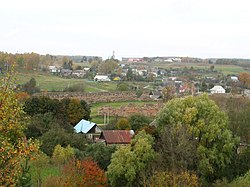Kreva
Крэва (
Belarusian) | |
|---|---|
 | |
| Coordinates: 54°18′37″N 26°17′11″E / 54.31028°N 26.28639°E | |
| Country | Belarus |
| Region | Grodno Region |
| District | Smarhon District |
| Time zone | UTC+3 ( MSK) |
Kreva ( Belarusian: Крэва, IPA: [ˈkrɛva]; Russian: Крево, romanized: Krevo; Lithuanian: Krėva, Krẽvas; Polish: Krewo) is an agrotown in Smarhon District, Grodno Region, Belarus. It serves as the administrative center of Krevas selsoviet. [1] [2]
The first mention dates to the 13th century. The toponym is derived from the name of the Krivichs tribe. [3]

History
This section needs additional citations for
verification. (November 2023) |
The Kreva Castle, constructed of brick, was built by the Grand Duke of Lithuania Gediminas in ethnically Lithuanian lands. [4] After his death in 1341, Kreva became the patrimony of his son and successor, Algirdas. In 1382, the Grand Duke Kęstutis was imprisoned in Kreva during the Lithuanian Civil War and subsequently murdered on the order by his nephew Jogaila.
The ruins of the castle were severely damaged during World War I, as they were near the front lines. They remain extant to the present day.
In 1385, the Union of Krewo (Act of Kreva) was signed in Kreva.
In 1387, following the Christianization of Lithuania, the Grand Duke Jogaila established the first Catholic parish in the Lithuanian pagan lands and built a church which is now known as the Church of St. Mary.
Before World War II, 500 Jews lived in the village. After the German occupation of the town they were kept imprisoned in a ghetto and used as slave labourers in harsh conditions. [5] They were deported in other ghettos in Vilnius and Ashmyany in 1942. [6]
Notable people
- Nathan Mileikowsky, a Zionist rabbi, grandfather of Benjamin Netanyahu, Prime Minister of Israel
- Al Kelly, vaudeville comedian
References
- ^ Gaponenko, Irina Olegovna (2004). Назвы населеных пунктаў Рэспублікі Беларусь: Гродзенская вобласць. Minsk: Тэхналогія. p. 348. ISBN 985-458-098-9.
- ^ "Кревский сельсовет". Сморгонский районный исполнительный комитет (in Russian). 3 March 2017.
- ^ Жучкевич В. А. Краткий топонимический словарь Белоруссии. — Мн.: Изд-во БГУ, 1974. С. 182.
- ^ "Krevas". Visuotinė lietuvių enciklopedija (in Lithuanian).
- ^ "Krewo - Virtual Shtetl". sztetl.org.pl. Retrieved 2017-07-15.
- ^ "המכון הבין-לאומי לחקר השואה - יד ושם". yadvashem.org. Retrieved 2017-07-15.
External links
-
 Media related to
Kreva at Wikimedia Commons
Media related to
Kreva at Wikimedia Commons
Kreva
Крэва (
Belarusian) | |
|---|---|
 | |
| Coordinates: 54°18′37″N 26°17′11″E / 54.31028°N 26.28639°E | |
| Country | Belarus |
| Region | Grodno Region |
| District | Smarhon District |
| Time zone | UTC+3 ( MSK) |
Kreva ( Belarusian: Крэва, IPA: [ˈkrɛva]; Russian: Крево, romanized: Krevo; Lithuanian: Krėva, Krẽvas; Polish: Krewo) is an agrotown in Smarhon District, Grodno Region, Belarus. It serves as the administrative center of Krevas selsoviet. [1] [2]
The first mention dates to the 13th century. The toponym is derived from the name of the Krivichs tribe. [3]

History
This section needs additional citations for
verification. (November 2023) |
The Kreva Castle, constructed of brick, was built by the Grand Duke of Lithuania Gediminas in ethnically Lithuanian lands. [4] After his death in 1341, Kreva became the patrimony of his son and successor, Algirdas. In 1382, the Grand Duke Kęstutis was imprisoned in Kreva during the Lithuanian Civil War and subsequently murdered on the order by his nephew Jogaila.
The ruins of the castle were severely damaged during World War I, as they were near the front lines. They remain extant to the present day.
In 1385, the Union of Krewo (Act of Kreva) was signed in Kreva.
In 1387, following the Christianization of Lithuania, the Grand Duke Jogaila established the first Catholic parish in the Lithuanian pagan lands and built a church which is now known as the Church of St. Mary.
Before World War II, 500 Jews lived in the village. After the German occupation of the town they were kept imprisoned in a ghetto and used as slave labourers in harsh conditions. [5] They were deported in other ghettos in Vilnius and Ashmyany in 1942. [6]
Notable people
- Nathan Mileikowsky, a Zionist rabbi, grandfather of Benjamin Netanyahu, Prime Minister of Israel
- Al Kelly, vaudeville comedian
References
- ^ Gaponenko, Irina Olegovna (2004). Назвы населеных пунктаў Рэспублікі Беларусь: Гродзенская вобласць. Minsk: Тэхналогія. p. 348. ISBN 985-458-098-9.
- ^ "Кревский сельсовет". Сморгонский районный исполнительный комитет (in Russian). 3 March 2017.
- ^ Жучкевич В. А. Краткий топонимический словарь Белоруссии. — Мн.: Изд-во БГУ, 1974. С. 182.
- ^ "Krevas". Visuotinė lietuvių enciklopedija (in Lithuanian).
- ^ "Krewo - Virtual Shtetl". sztetl.org.pl. Retrieved 2017-07-15.
- ^ "המכון הבין-לאומי לחקר השואה - יד ושם". yadvashem.org. Retrieved 2017-07-15.
External links
-
 Media related to
Kreva at Wikimedia Commons
Media related to
Kreva at Wikimedia Commons

